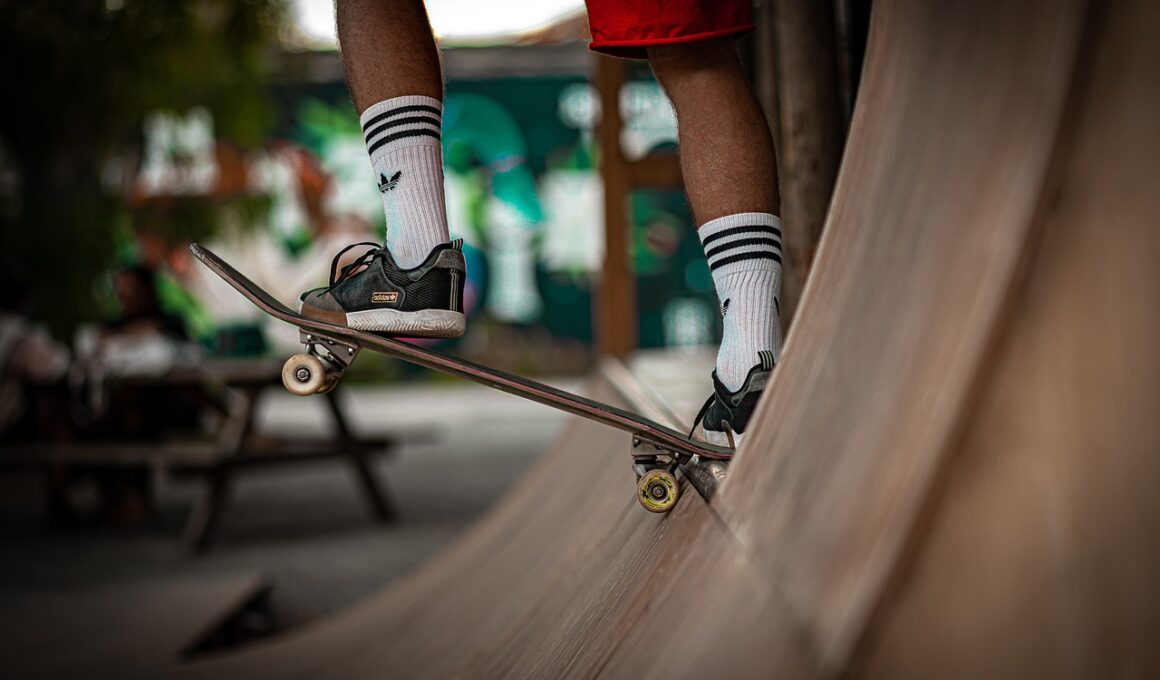Optimizing Performance in Extreme Sports with Balance Training
Extreme sports demand a unique combination of strength, agility, and balance. For athletes in disciplines such as skateboarding, snowboarding, or mountain biking, balance training is crucial. It helps enhance coordination, enabling athletes to perform stunts and maneuvers more effectively. Proper balance reduces the likelihood of injuries, offering athletes additional confidence on challenging obstacles. Balance training focuses on enhancing proprioception, which is the body’s ability to sense its position in space. This sense allows for more precise movements during extreme sports activities. The incorporation of dynamic stability exercises improves an athlete’s ability to adapt quickly to sudden changes. Athletes can develop skills such as catching themselves during falls or adjusting to uneven terrains. Moreover, balance training strengthens core muscles, contributing to overall body stability. This enhanced core support can prevent falls and improve the overall performance in extreme sports. Prioritizing balance training can lead to improved techniques and increased time spent practicing complex maneuvers. Athletes should integrate specific balance drills into their training routines, aiming for progressive challenges and varied environments, which will ultimately elevate their performance in extreme sports.
One effective way to enhance balance is through the use of unstable surfaces. Tools such as balance boards, stability balls, and BOSU trainers challenge the athletes’ equilibrium. These unstable surfaces force the body to engage smaller stabilizing muscles that typically remain inactive during standard exercises. When using these tools, athletes can perform various movements, including squats, lunges, and push-ups, which helps refine muscular coordination. This not only improves balance but also helps strengthen the muscles involved, contributing to overall athletic performance. Additionally, performing exercises such as single-leg stands on these unstable surfaces adds an extra layer of difficulty. Furthermore, incorporating multitasking into balance drills can significantly increase training effectiveness. For instance, an athlete can practice balance while catching a ball or performing a discussion. This mimics the unpredictable nature of real-life extreme sports, where athletes must react quickly to changes in their environment. Consistent practice of these techniques will help athletes develop superior balance skills. The combination of skill and strength achieved through these exercises ensures performance enhancement during extreme sports. To maximize benefits, athletes should focus on consistency and gradually increase the complexity of the tasks they perform.
The Importance of Core Strength in Balance Training
Core strength is vital for maintaining balance and coordination. A strong core stabilizes the body during movements, allowing athletes to perform tricks and jumps effectively. Training the core involves engaging specific muscle groups that support the spine and improve posture. Engaging the transverse abdominis, rectus abdominis, obliques, and lower back muscles creates a functional support system. A robust core provides better control and balance, which is essential for maneuvers in extreme sports. Furthermore, a stable core assists in distributing weight evenly throughout the body. This distribution minimizes the risk of overuse and strain injuries. It’s crucial for athletes to incorporate core strengthening exercises in their training routines. Exercises like planks, Russian twists, and Pilates can enhance muscle strength, stability, and engagement. These exercises help athletes maintain balance during dynamic movements, like jumps and turns. Additionally, developing core strength contributes to quicker recovery times after falls, allowing athletes to resume their routines promptly. Also, strong core muscles aid in overall performance, providing power while executing skills in extreme sports. Thus, integrating core-focused workouts can vastly benefit athletes aiming for exceptional results.
Another important aspect of balance training for extreme sports is proprioceptive exercises. These exercises help enhance kinesthetic awareness, which is necessary for efficiently navigating uneven surfaces and unpredictable environments. Proprioceptive training can include various drills that require athletes to recognize their body positioning while in motion. For instance, exercises that involve closing the eyes while balancing challenge the athlete’s proprioceptive system. This added difficulty forces the body to rely on instinct instead of visual cues. Additionally, unanticipated movements, like lateral hops or sliding motions, can substantially develop proprioceptive responses. This awareness is especially beneficial in extreme sports where rapid adjustments can prevent serious falls or accidents. Performing agility drills that include sudden stops and changes in direction can further improve responsiveness. Athletes should engage in consistent proprioceptive training alongside traditional balance work. Furthermore, dedicated training sessions focusing solely on this aspect can foster adaptability in unpredictable environments. Balancing on various terrains while performing tricks increases natural instincts and sharpens responses. This practice leads to overall improved capabilities, enhancing performance and safety in extreme sports. Thus, incorporating proprioceptive exercises forms a comprehensive training approach.
Cross-Training for Improved Balance
Cross-training is an excellent approach to enhance balance and coordination in athletes. By incorporating various sports and activities, athletes can improve their overall athletic capabilities. Engaging in different forms of exercise promotes muscle engagement and prevents overuse injuries. For instance, a skateboarder can benefit from yoga, enhancing flexibility and core strength while improving balance. Likewise, a surfer may use strength training to create a muscular foundation for stability. Each sport brings unique challenges that can develop specific balance skills, translating to improved performance in extreme sports. Additionally, cross-training facilitates recovery by working different muscle groups. This variation also ensures a more holistic approach to training. Athletes can develop agility and coordination through dance or martial arts, promoting mental sharpness and body awareness. Engaging in these activities fosters neural connections that enhance motor skills vital for extreme sports. Creating a diverse training plan, combining different sports, can offer holistic health benefits. Such breadth encourages both physical and mental agility, helping athletes to maximize their potential in their primary sport. Complementing their regular intensity training with cross-training activities provides overall balance and improved performance.
A regular assessment of balance skills is vital for the ongoing development of an athlete. Monitoring progress can help identify areas needing improvement and encourage adjustments to training routines. Professional assessments can provide athletes with insights into their balance abilities. Regular testing can include static balance, dynamic balance, and functional movement assessments. This evaluation process helps tailor training programs according to individual needs. Coaches and trainers can utilize various tools, such as balance scales, to quantify advancement. Additionally, maintaining an open dialogue about perceived difficulties during training can highlight specific balance challenges. Athletes can visually chart their progress to maintain motivation and commitment. Setting measurable goals and rewarding achievements can provide an additional incentive for improvement. Furthermore, athlete self-assessment enhances personal accountability, where individuals recognize their balance skill changes over time. Involving teammates in this evaluation process can foster a supportive training environment. Regular assessments combined with a dedicated approach can yield long-term benefits for athletes in extreme sports. Creating a culture of continuous improvement serves to motivate individuals and ensure balanced performance enhancement. This process ultimately leads to superior balance and coordination, contributing to athlete success.
Conclusion: Embracing Balance Training
In conclusion, optimizing performance in extreme sports significantly relies on dedicated balance training. The development of strength, coordination, and proprioception enhances athletic performance, reducing injury risks. A comprehensive training plan that includes various balance and core-strengthening exercises ensures athletes possess the skills necessary for extreme sports. Integrating unstable surfaces, cross-training activities, and proprioceptive drills will further hone balance abilities. Regular assessments help measure progress and promote necessary changes to training plans, ultimately maximizing performance. Embracing balance training serves as a foundation for achieving athletic excellence. Athletes should continually challenge their skills through progressive routines designed to foster adaptability. A commitment to balance training not only translates into enhanced performance but also improves an athlete’s overall physical condition. Effective balance allows for greater control and confidence in executing complex maneuvers. Whether on skateboards, surfboards, or mountain bikes, a solid foundation in balance training can lead to improved outcomes in various scenarios. Therefore, athletes must prioritize balance training within their routines to achieve lasting success and durability in extreme sports. With the right strategies and mindset, athletes will maximize their potential and enjoy the thrill of pushing their limits.


